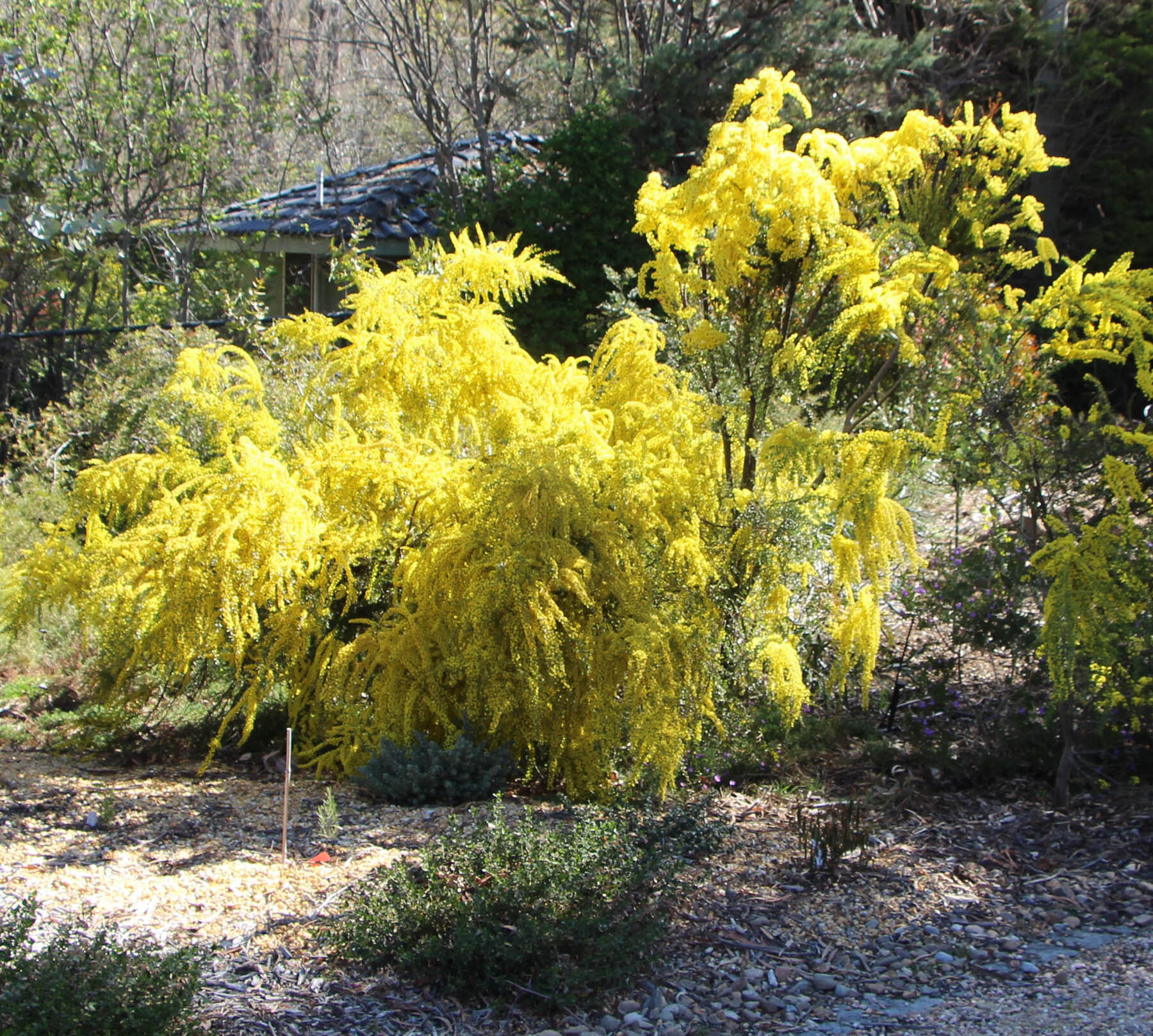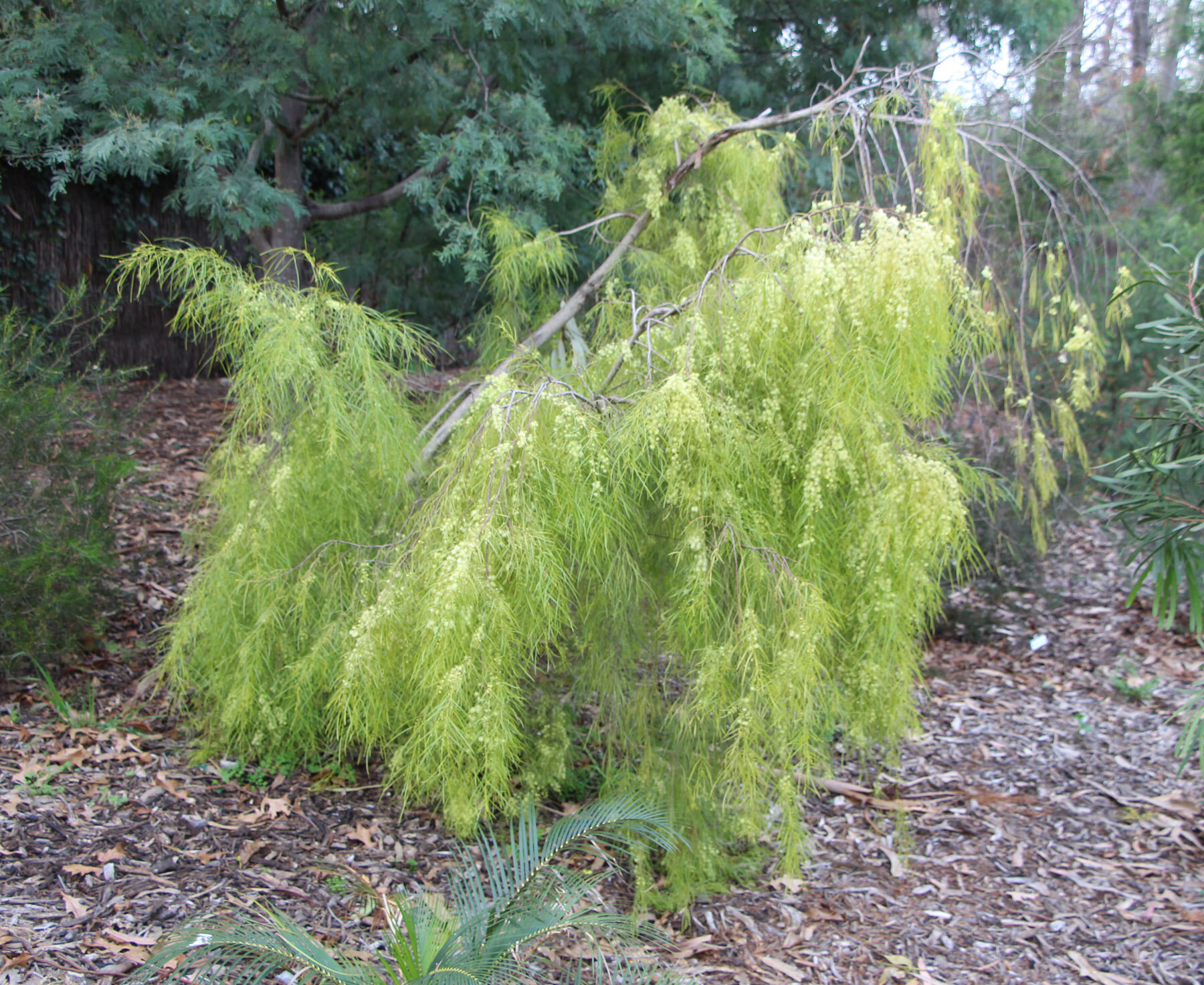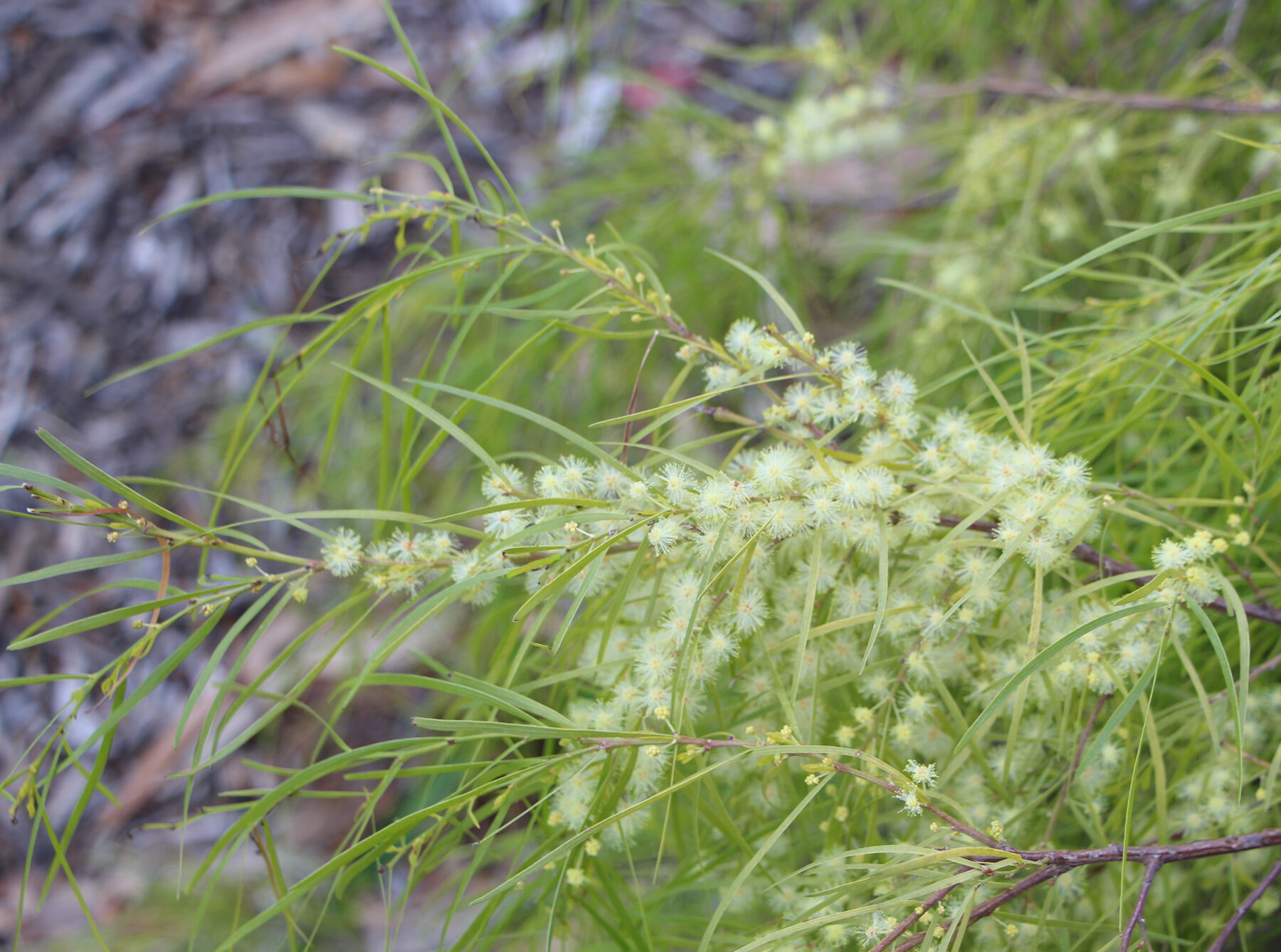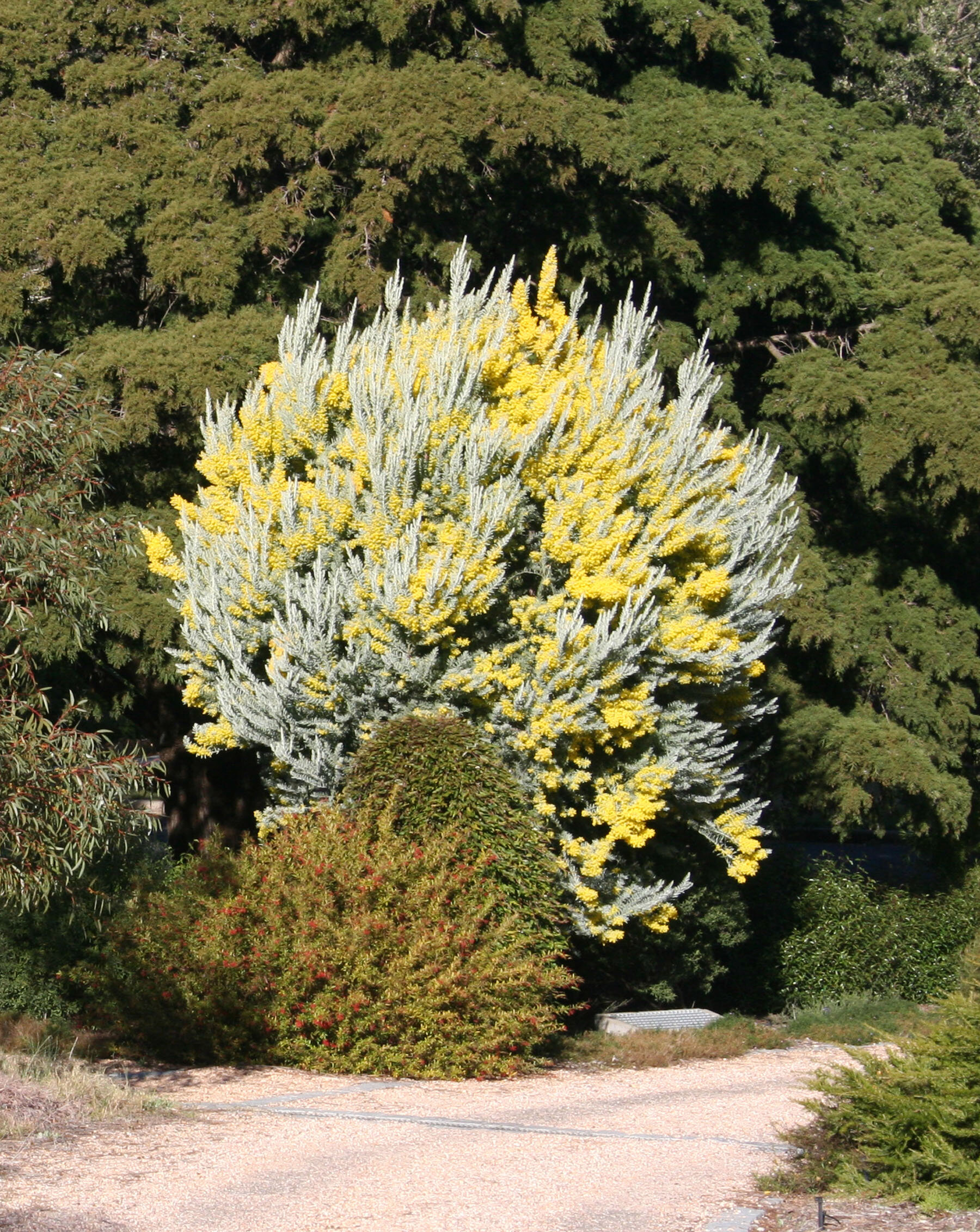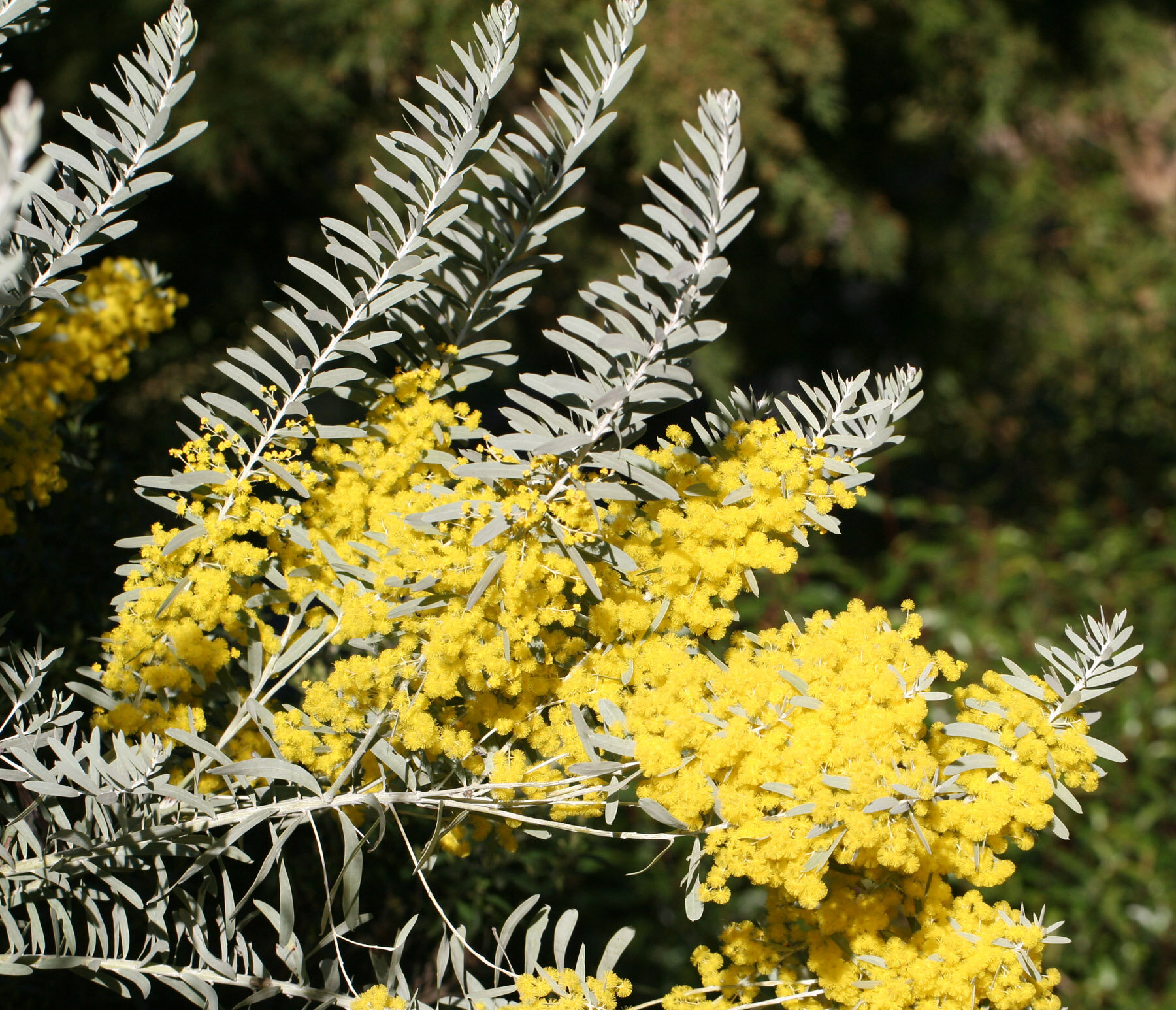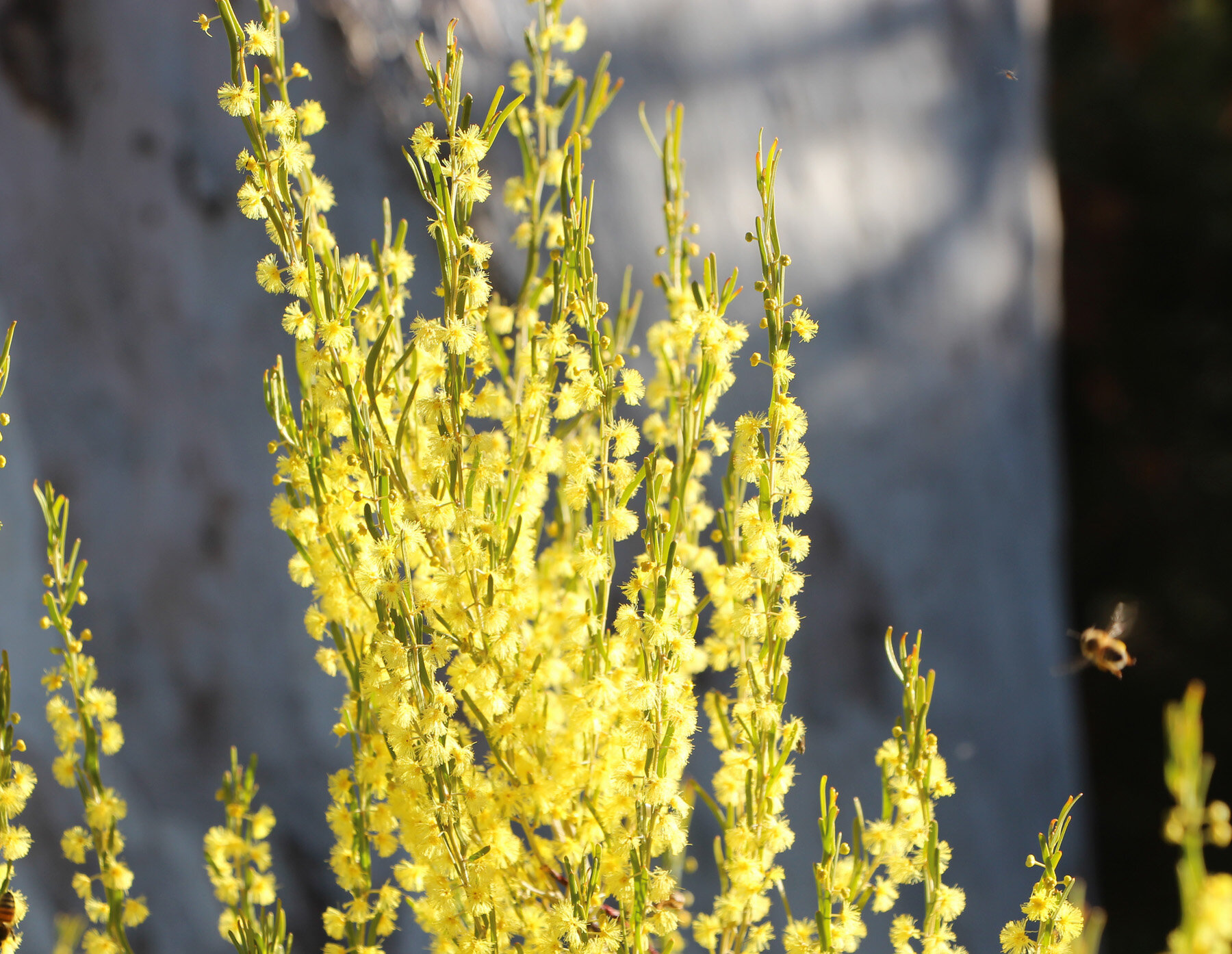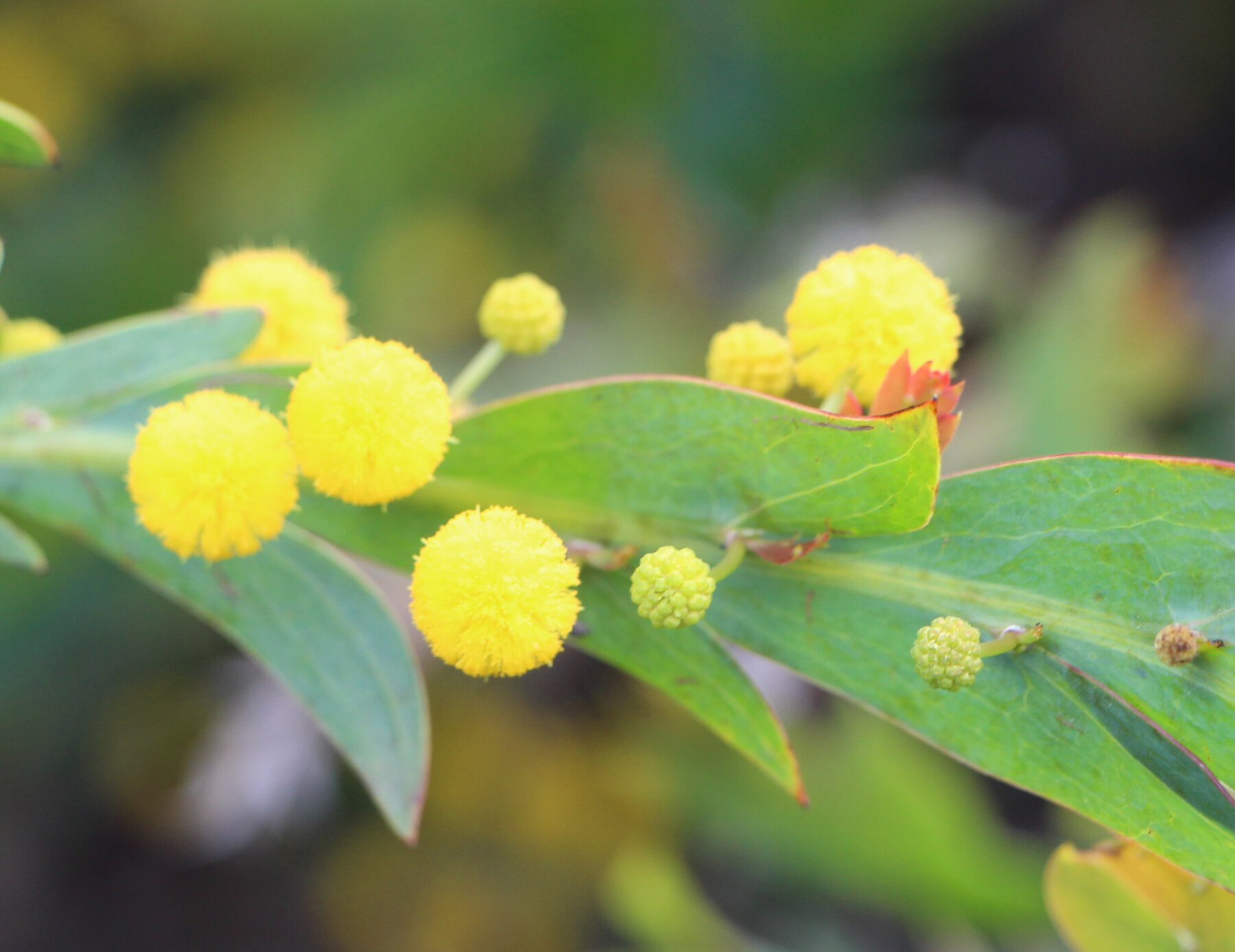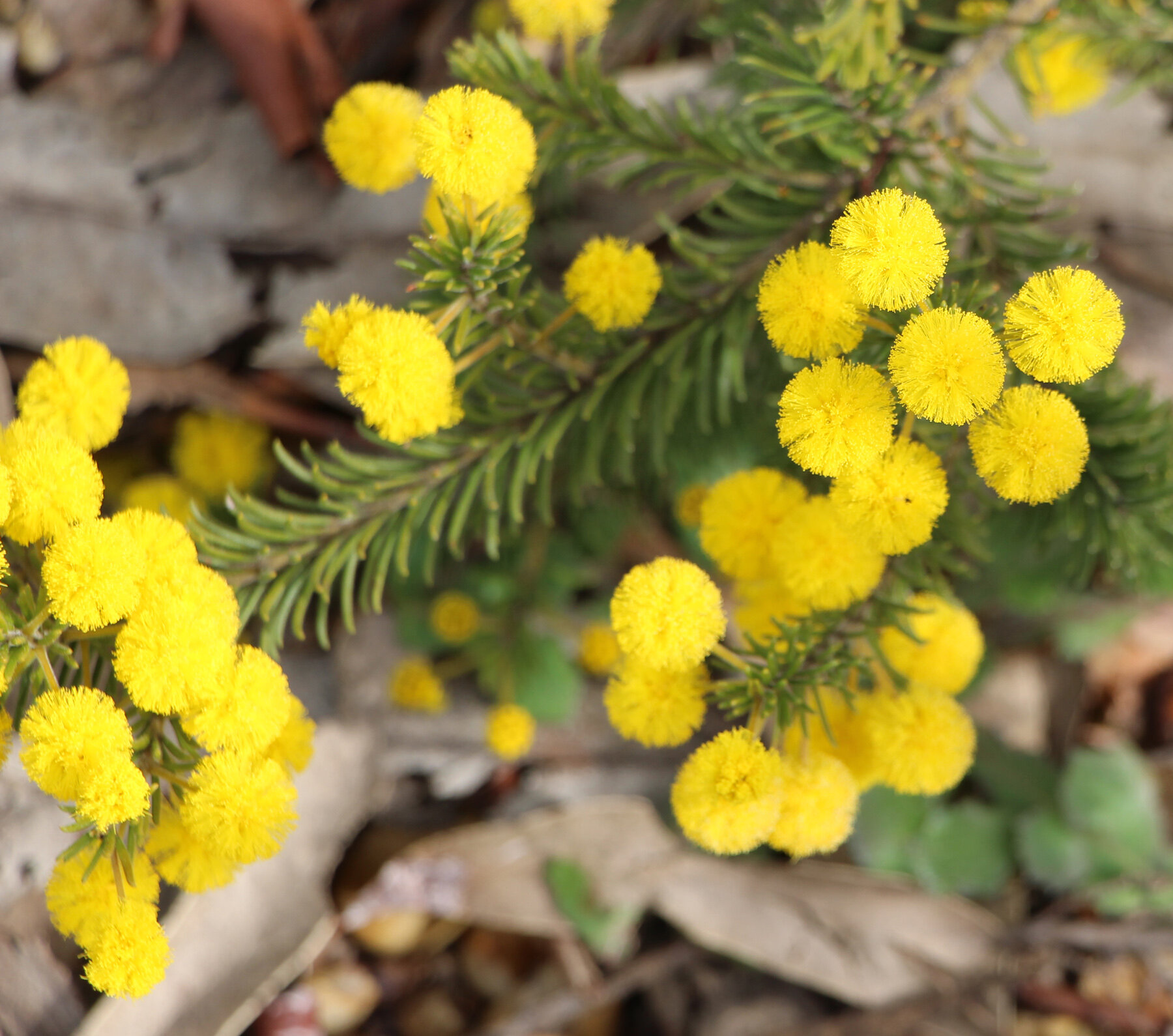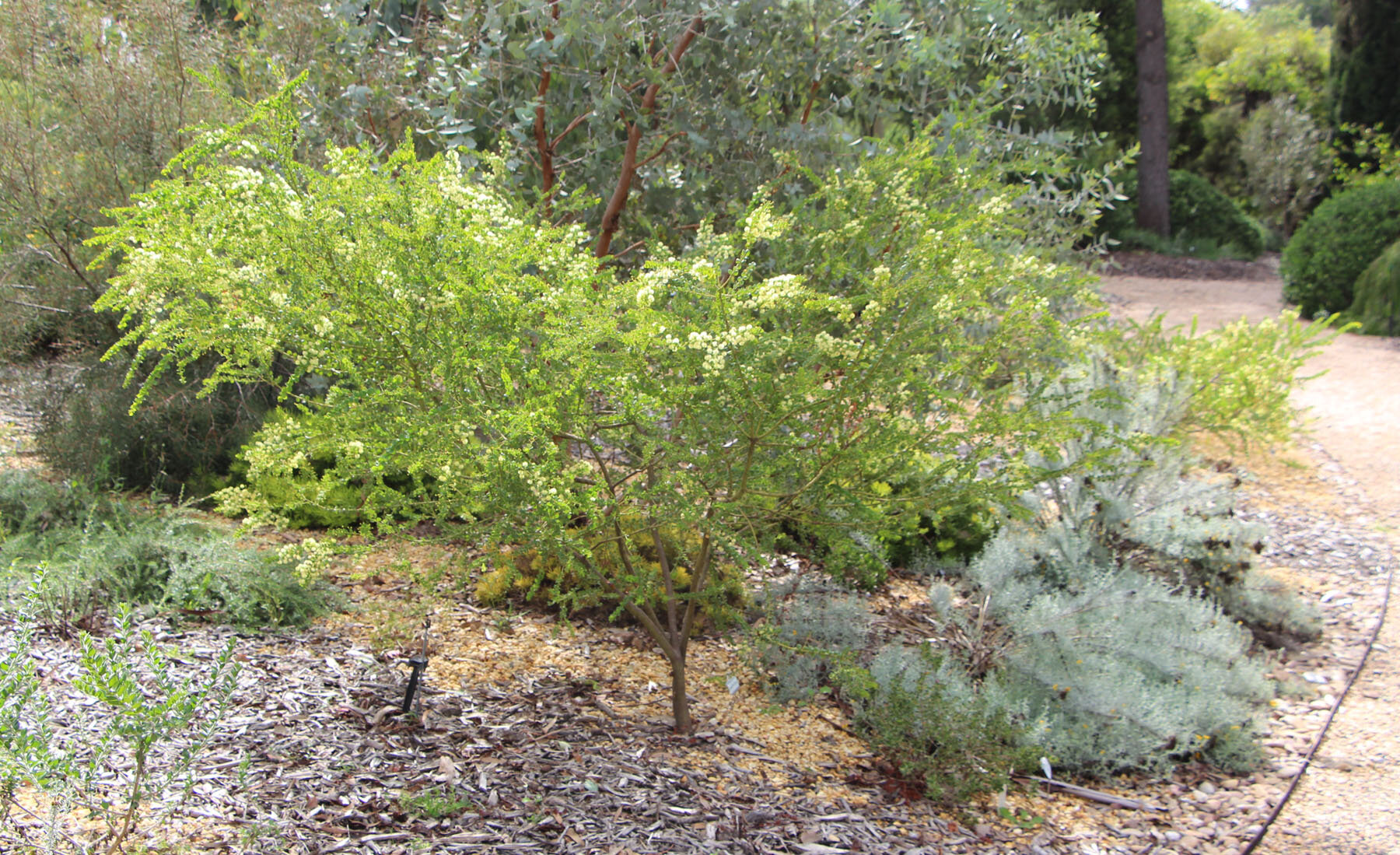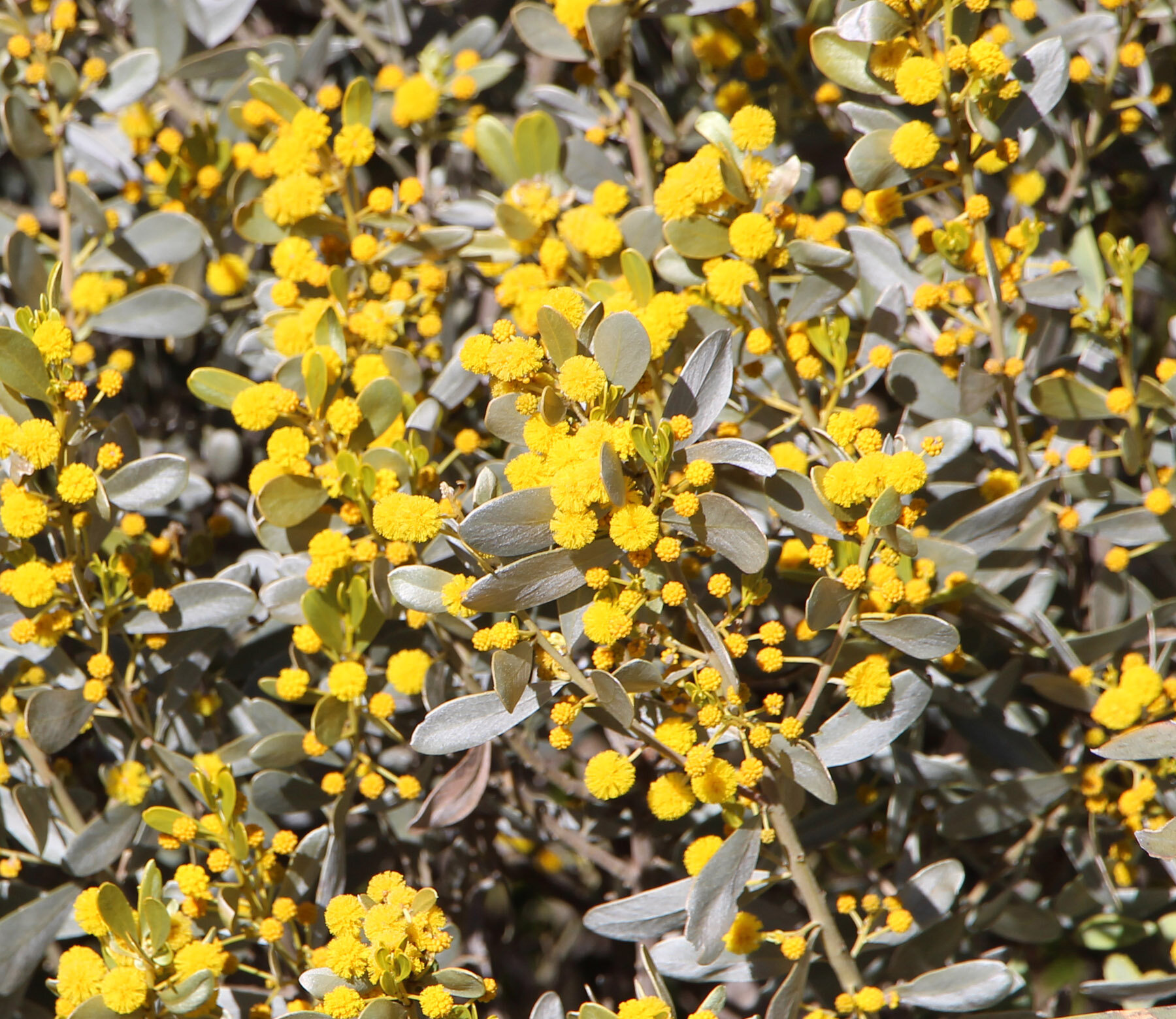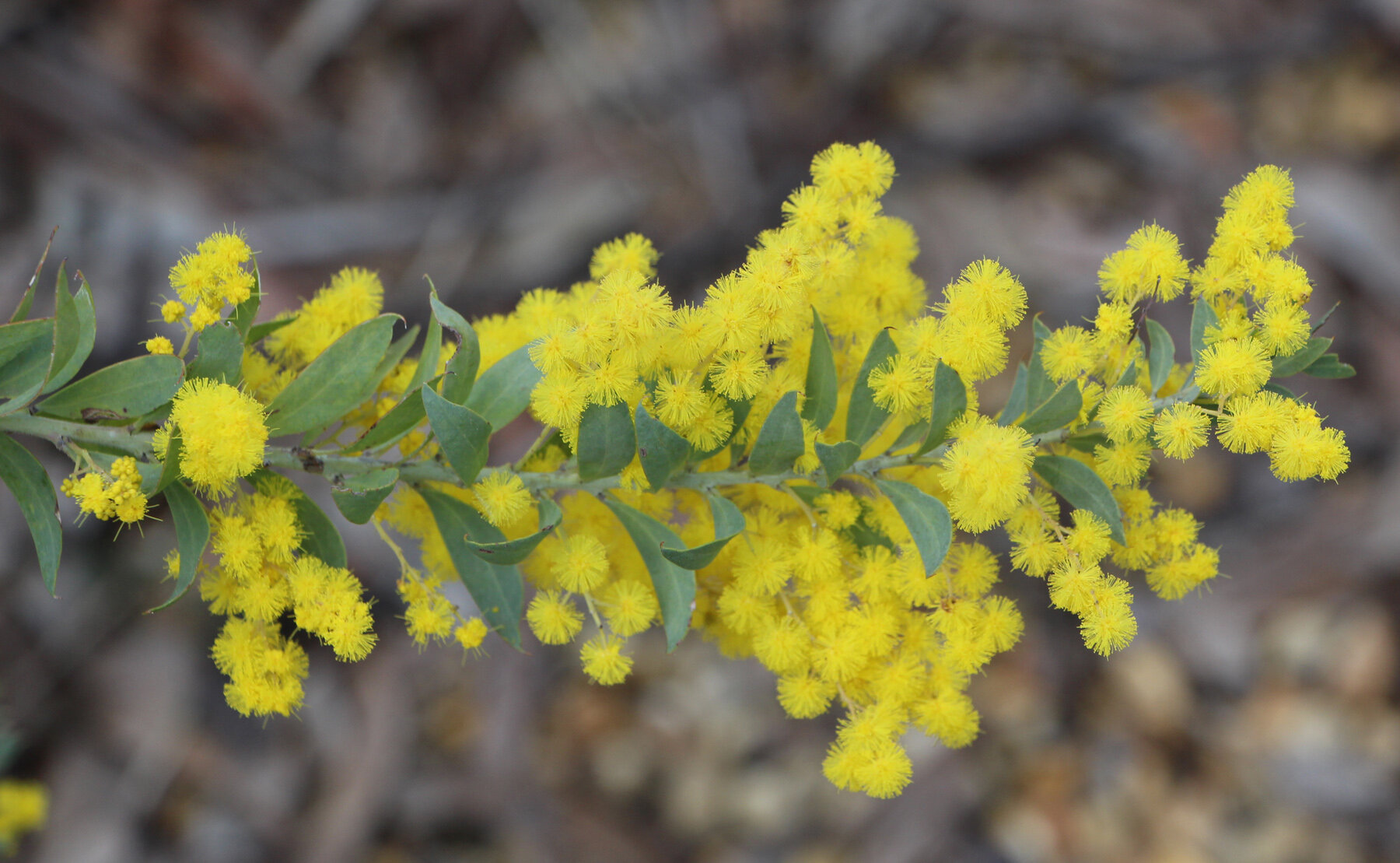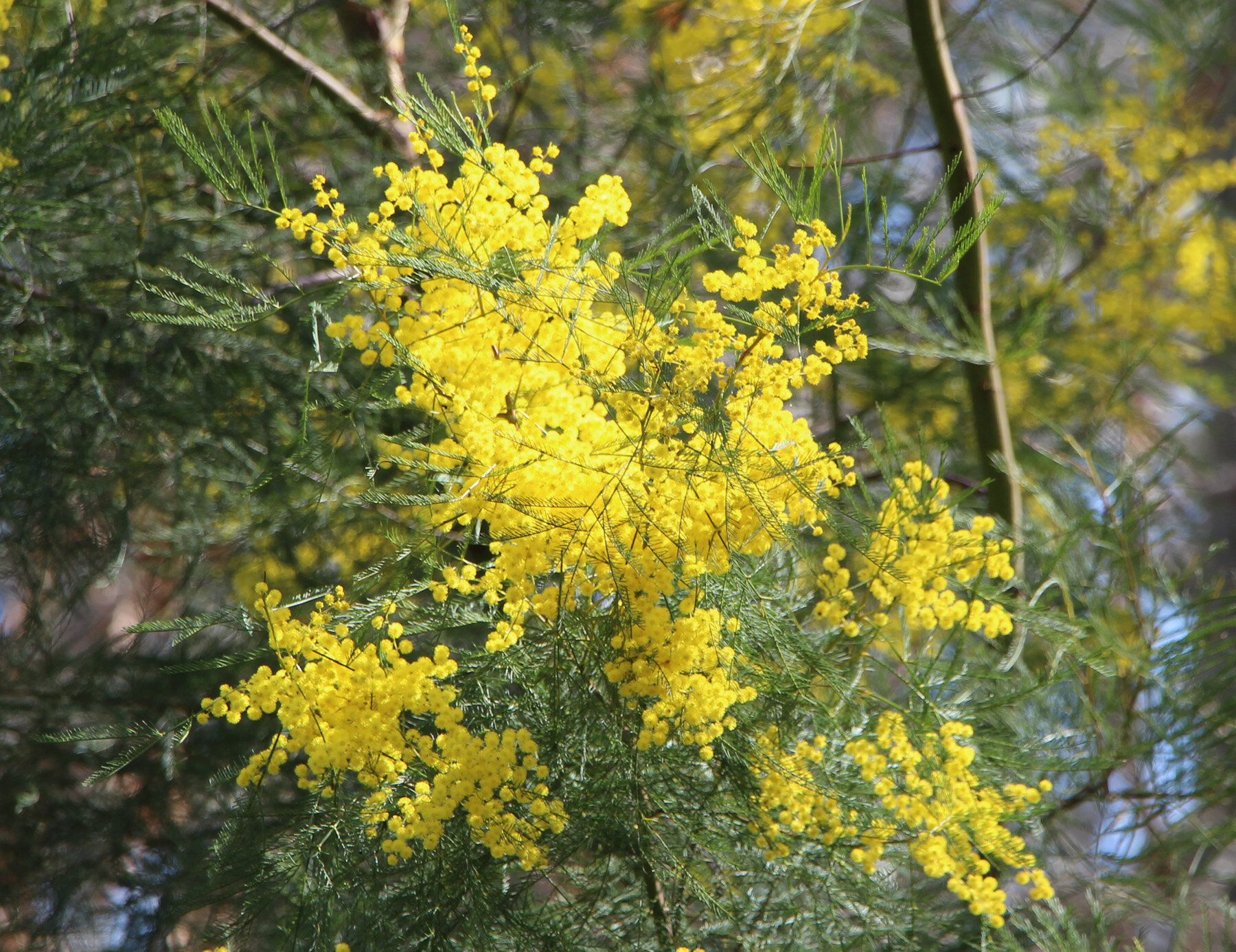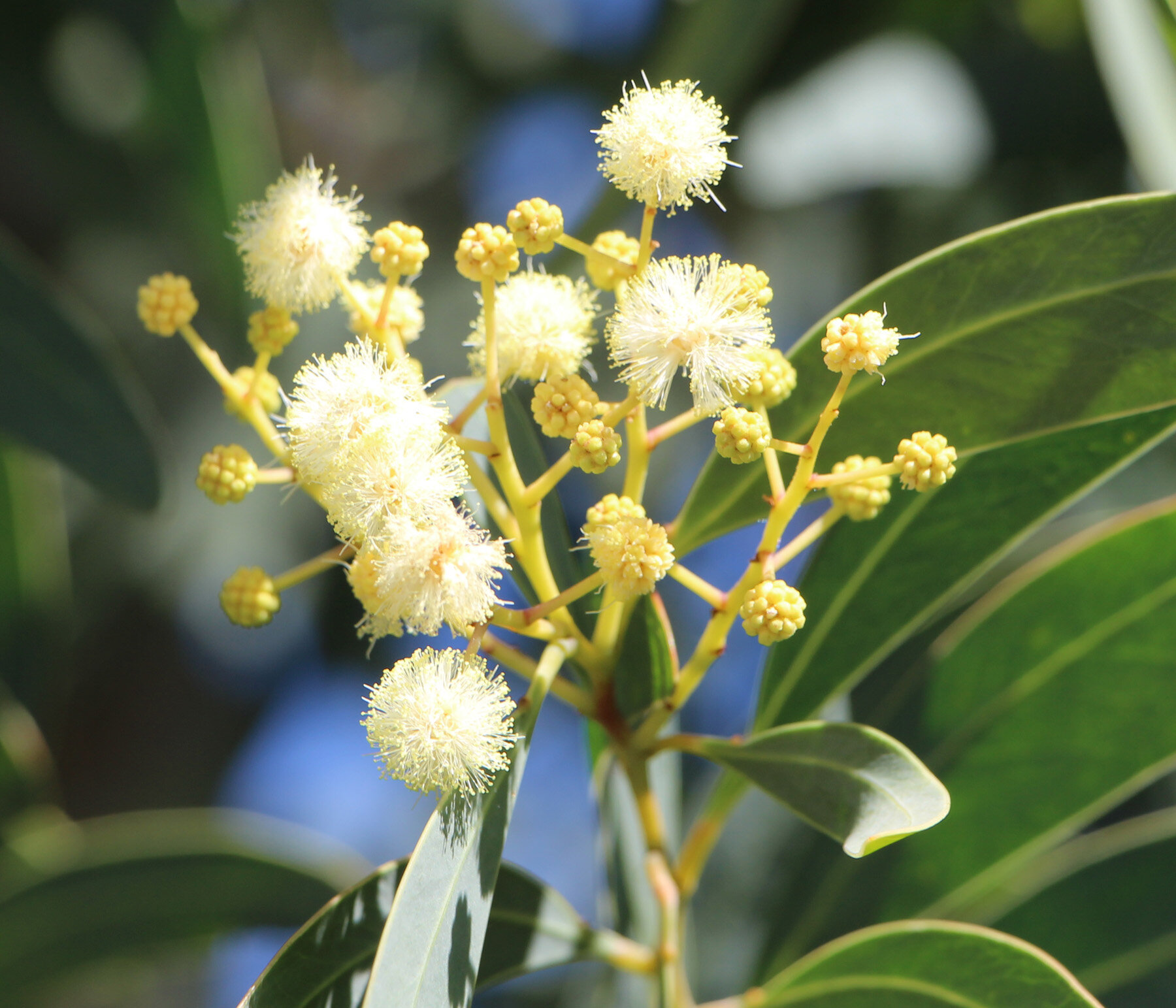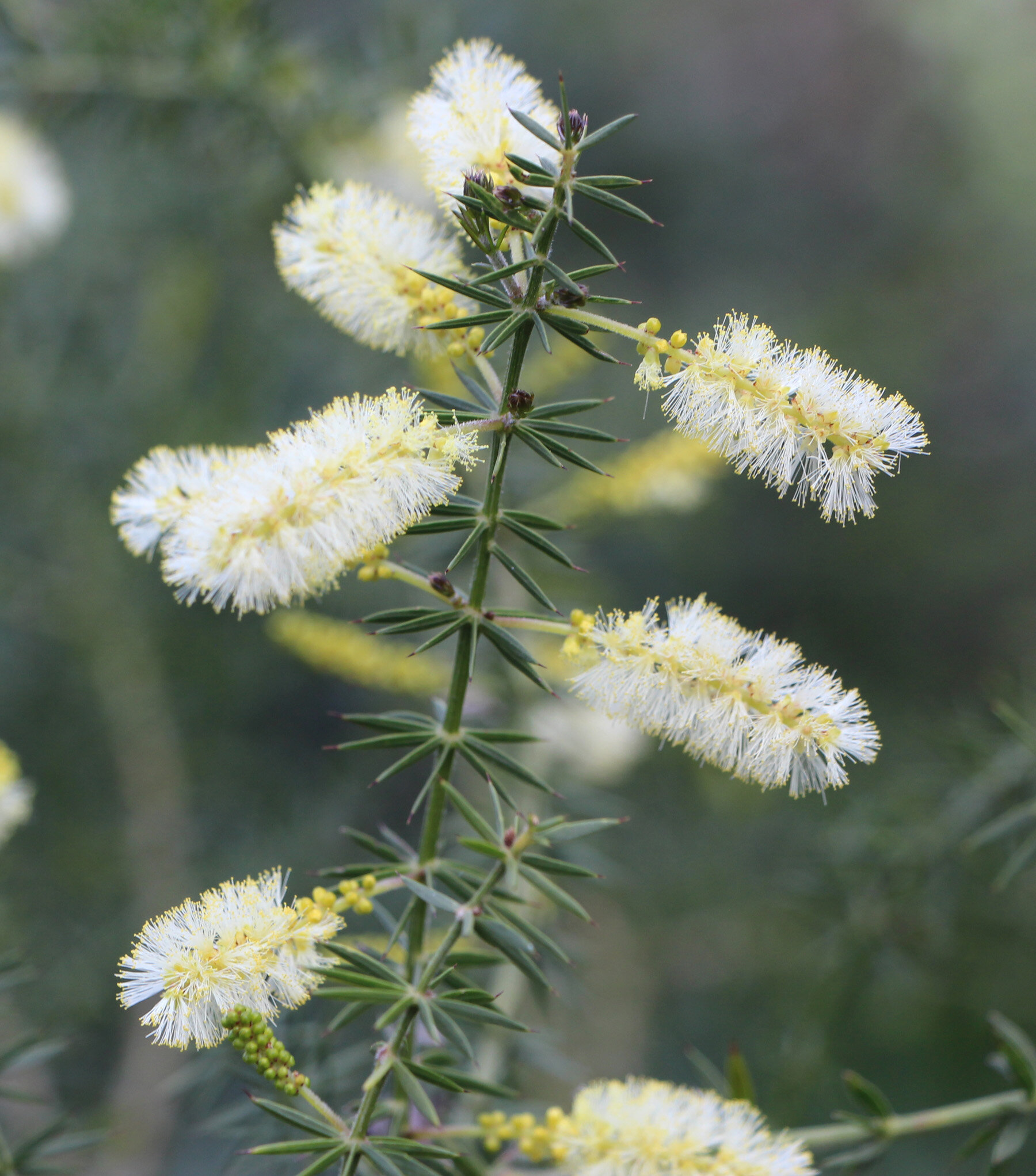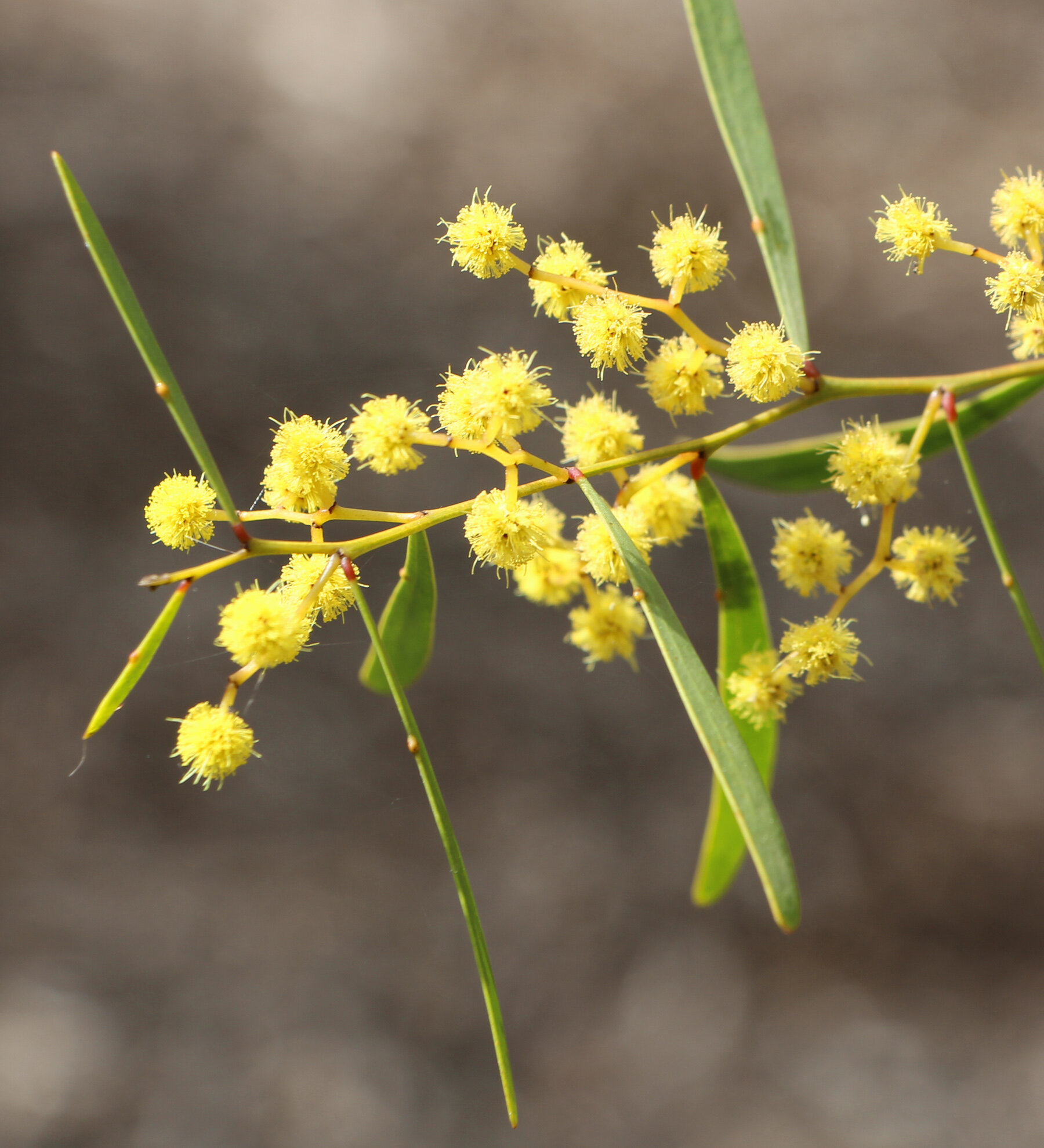Acacias
Acacia denticulosa flowers
We now have nineteen years’ experience growing wattles on our property on Wickham Crescent in the middle of Canberra. The garden is a pie shaped wedge covering about a hectare and slopes ten metres from front to back. The soil here is clay, much to our consternation, as we were used to gardening for thirty years in pure sand on Long Island, NY. Clay is a different proposition altogether but needs the same treatment as sand for completely different reasons. The addition of lots of humus is key, in the the first case to break down the soil and in the second to build it up. We originally added 30 truckloads (15 cubic metres each) of mulch to our soil in Canberra and have continued to add about ten truckloads of ‘coarse forest litter’ each year. Our soil has improved markedly and we have plenty of healthy worms in our soil. For the first few years we had regular visits from an aerating crew of Straw-Necked Ibis who probed our soil for grubs to the depth of 30cm. They have now moved on to greener pastures (e.g. Parliament House grounds). We have tried to make our garden as bird friendly as possible, by creating three layers of dense and sometimes prickly shrubs for their shelter and nest building, and providing plenty of nectar bearing plants. We have been gratified by the growth of both numbers of birds overall and species of birds in the garden from 35 when we began to over 105 now.
Acacia leprosa ‘Scarlet Blaze’
We grow 68 different wattles at time of writing, August 2022, and have planted 423 different plants of which 127, or 39%, remain. We have had much success with acacias in the garden but this does not mean that we have not had plenty of failures, (in fact 60% failure), especially in the beginning when we were establishing the microclimates needed for good growth. We began with a virtually bare block and it took time to get enough growth on the trees to make some needed shelter from frost and wind. It is worth mentioning that some of the so called ‘failures’ were because certain acacias outgrew their position and had to be removed. We also ended up removing several Acacia leprosa ‘Scarlet Blaze’ after three years of beautiful blooms because they were too brittle and collapsed in the wind. we have replanted this wattle in a more protected position in the garden.
Acacia acinacea
We have many favourite acacias growing in our garden at present , A. acinacea – Gold Dust Wattle, A. boormanii – Snowy River Wattle, A. ‘Burgundy Cascade’, A. cardiophylla – West Wyalong Wattle, A. caerulescens – Buchan Blue Wattle, A. cognata ‘Lime Magik’, A. convenyi – Blue Bush, A. denticulosa – Sandpaper Wattle, A. doratoxylon – Currawang, A. gracilifolia – Graceful Wattle, A. howittii – Sticky Wattle, A. pendula – Weeping Myall or Boree, A. pravissima nana “Golden Glow’, A. pruinosa, A. spectabilis – Mudgee Wattle, and saving the very best for last, A. subulata.
A. cognata ‘Lime Magik’
The foundation planting in our garden included particularly A. boormanii , Snowy River Wattle, A. cardiophylla , West Wyalong Wattle and A. spectabilis , Mudgee Wattle, all reliable and free flowering in Canberra. These shrubs are visited regularly by many little birds. We originally had a couple of A. iteaphylla, a really beautiful shrub that thrives in the protected Sculpture Garden at the Australian National Gallery. Our two specimens developed black mould and could not be saved despite spraying etc. Interestingly, a Banksia ericifolia ‘Golden Girl’, which was near the acacias and had sulked for several years, immediately put on tremendous growth and flowered amazingly as soon as the acacias were removed. Acacia root systems obviously beat Banksia root systems, at least in this case.
A. convenyi – Blue Bush
Originally we also tried many A. cognata ‘Green Mist’ and ‘Limelight’ in our garden but these do not tolerate the frost well enough to keep, so we have now removed all of these plants. The A. cognata varieties that we do grow are either under shelter, like ‘Lime Magik’. We continually ask the plant breeders that we know to develop a suite of really frost hardy A. cognata. The many cultivars of this plant are so attractive and varied that we would like to be able to grow more of them.
A.. flexifolia
We have cut back the suckering A. boormanii to contain them to particular parts of the garden. They make a wonderful regenerating haven for small birds, especially thornbills and silvereyes
A. glaucoptera (left) and A. gordonii (right)
At present we have only one wattle grown as a standard, A. suaveolens, which blooms sweetly, according to its common name, all through winter. It also produces copious shiny black seed in attractive seed pods. We would like to add more standard wattles as it gives variety to the garden and adds another layer. However, it must be said that standard wattles are still very expensive at this point and it would be better if they became more easily available and the price came down.
Acacia subulata
Acacia subulata must be singled out for praise. This wattle blooms all year, in a serial fashion, from branch tip upwards, it smells delicious, it has delightful light ferny foliage, decorative seed pods and grows fast. I find it hard to understand why gardeners complain about the fast growth, and in some cases, short life of wattles. How marvellous to have a plant that grows fast and can easily be replaced when it starts to decline. In the US we gardened with more established plants that had been grown by gardeners longer and hybridised over many years. In one way it was gratifying to have plants which grew reliably to the size and shape on the plant label and lasted for generations.
Acacia pruinosa
On the other hand, we wanted to develop more gardens and try more plants, but ran out of room. Running out of space is less of a problem in a native garden where most of the plants are relatively new to gardens and have yet to be developed to ‘reliable’ status. For example we purchased five A. pravissima ‘Bushwalk Baby’ at the same time from the same nursery. We wanted them to be prostrate as it said on the label and to spill over a wall, but three decided to do just that and the other two grew upright and quite large. This is the sort of variablity that native plant growers can expect at this stage of the development of Australian native garden plants. We have also had to remove wattles like A. pravissima nana ‘Little Nugget’ as they have so outgrown their space to become unworkable. The label on ‘Little Nugget’ listed height to 1.5m, but ours grew quickly to over 2m and were headed upwards and outwards - nothing ‘nana’ about them at all.
A. podalyriifolia or Queensland Silver Wattle
We love A. acinacea, the Gold Dust Wattle, especially the smaller, denser tetraploid form. This plant is one of the showiest in the Australian National Botanic Garden and stands out in the sea of wattle bloom there in early spring.
A. acinacea, the Gold Dust Wattle
We planted several Acacia cremiflora four years ago in full sun. This plant forms a small rounded shrub 1.5m high and 2m wide, with green circular foliage on arching branches. Plentiful cream flowers occur several times a year and make this a really useful wattle for the garden. Attractive seed pods add to its worth as these are easily germinated.
Acacia cremiflora
We will continue to plant wattles for their brilliant foliage, their knockout spring display and their fast growing qualities. Besides, who can resist a little charmer like Acacia willendowiana, the Grass Wattle, with its long thin foliage and yellow ball flowers?
A. argyraea (left) and A. hakeoides (right)
Acacia acinacea – Gold Dust Wattle
We planted six of these straggling shrubs, 2-3m high and 2m wide, with masses of showy golden ball flowers over the years 2008-10. This plant is native to SA, Vic, and NSW. The preferred form is tetraploid, which is more compact. This plant is frost tolerant and attracts seed feeding birds. We have removed all but two of these wattles for various reasons, broken down by storms, too large for their position, looking poorly. Sadly all of these have now been removed.
Acacia acuminata – Raspberry Jam Wattle
We planted one of these slender shrubs, 5m high x 3m wide, with long fine foliage and yellow rod flowers in October 2017. This first plant did not make it through winter ’18 so we have planted another one in January 2021. No flowers so far, 2024.
Acacia aff verniciflua ‘Avenal’ ‘Sigma Weeping Wattle’
This weeping shrub, 1.5m high x 1.5m across, has aromatic foliage and bright yellow perfumed flowers in spring. It grows in full sun or part shade, in well drained clay or sandy soils, and withstands heavy frost. This is a very attractive ‘filler’ wattle which does not take up much room.
Acacia anceps (photos above)
We planted this bushy, spreading shrub, 3 m high x 2m wide, with yellow ball flowers over a long period, in October 2011. This plant is native to southwestern WA. Removed 2023 as was looking poorly.
Acacia aneura - Mulga
We have planted three of these small trees or large shrubs, 4m high x 2m wide, and often often multi-stemmed. These plants have narrow greyish phyllodes and yellow rod flowers mainly in spring. So far in our garden they are very slow to grow.
Acacia aphylla - Leafless Rock Wattle
We have tried to grow Acacia aphylla, or Leafless Rock Wattle, twice, in November 2008 and October 2015, but both died after two or three years. This plant has leafless spiny branches, yellow ball flowers and purplish-grey seed pods. This plant comes from Darling Range, WA and is listed as rare. We have planted a new one in a pot in September 2023.
Acacia argyraea (photos above)
We planted this shrub, 0.5-4m high and 1-2m wide, with narrow leathery grey leaves and pale yellow rod flowers, in November 2009. We were trying an experiment, as this wattle was recommended for hot inland regions, and is native to the Northern Territory. This plant has proved hardy in our frosty garden and blooms reliably each year, needs no pruning, and forms a pleasing, dense, vase shaped plant. Sadly removed this plant February 2024 for failure to thrive.
Acacia baileyana purpurea – Purple Cootamundra Wattle (photos above)
We planted this hardy wattle, 5-8m high and wide, with fern like foliage with a bright purple tint, and winter flowering gold ball blossoms, in August 2014. The purple seed pods are a welcome feature and remain on the tree over a long period after flowering.
Acacia beckleri - Barrier Range Wattle
We have planted three of these shrubs, to 3 m high, which often spread widely., in 2013, 2017 and 2019, This plant is native to the Barrier Range, NSW and areas near Cobar and Jerilderie. The first plant died in December 2014 but we tried again having seen the fantastic gold ball flowers on this plant at ANBG. We have been rewarded with flowers this year, 2021, on both our plants.
Acacia ‘Bilby Blue’ (Photos above)
We planted this large shrub, 3m high and wide, with grey-green foliage and large bright yellow ball flowers, in April 2017. We were rewarded with our first flowers in August 2019 and this plant, developed at Bilby Blooms near Coonabarabran, now flowers reliably each June.
Acacia binervata
We were given a seedling of this small tree, 4-10m high x 4-10m wide, with a spreading habit, in March 2013. This tree has curved elliptic leaves and decorative globular cream flowers. The new growth gets frosted off in winters in our garden, but the tree recovers well. This tree is native to coastal NSW and Queensland.
Acacia binervia ‘Sterling Silver
We planted one of these hardy, mounding plants, 1.8m high x 3-4m wide, with velvety silver leaves and yellow rod flowers in November 2022. These plants are tolerant of windy sites and almost any soil, as long as it is well drained. We planted in the pot given to us by Fenner School, 31/10/22.
Acacia blayana – Blay’s Wattle
We have planted two of these tall trees, to 25 m high, with glabrous branches, grey-green leaves and globular heads of gold flowers in March 2023. These rare wattles are native to Wadbillinga National Park, located between Kybeyan and Belowra, southeastern NSW.
Acacia boormanii - Snowy River Wattle (photo below left)
We planted 35 of these graceful, rounded shrubs, 2-3 m high and wide, with smooth silvery stems and narrow grey phyllodes, from 2003-7. This plant bears profuse golden ball-shaped flowers in the spring. Small thickets of these suckering wattles provide nesting sites for smaller birds. This plant is native to the Snowy River area of southeastern Australia. All were cut in half in March 2024 to allow them to regenerate in more sun, now that the hedge behind them has been removed.
Acacia ‘Burgundy Cascade’ (photo above right)
We have planted seven of these weeping shrubs, height 3m x width 2m, with burgundy tipped leaves and pale yellow perfumed flowers in September 2012, February 2014 and February 2015. . The red foliage is really beautiful and there is a very pretty contrast among leaves, flowers and burgundy tips. We had to remove the first large one in December 2018 as it grew too large for the spot, 3m high x 7m wide. We have trimmed back the others in September 2019.
Acacia buxifolia - Box Leaf Wattle (photo below left)
We planted five of these wattles in June 2007, height 2-3m x width 2m, with foliage that is small and slightly rounded like that of an English Box. This adaptable wattle has thick pale green phyllodes and a spectacular display of brilliant yellow ball flowers from spring to summer. This plant is native to Queensland, NSW and Victoria. Most of these plants have died and we only have one remaining.
Acacia cardiophylla - West Wyalong Wattle (photo above right)
West Wyalong Wattle, 3-4m high, began as the most reliable of our wattles, with attractive feathery foliage and masses of bright yellow ball flowers in the spring. We planted 12 of these fast growing, tough plants in many different positions in the garden in 2003 and 2006, but they are a little frost sensitive in Canberra. We now have one remaining plant which was planted in February 2020, growing well.
Acacia cognata ‘Lime Magik’ (Photos below)
We planted two of these compact cultivars, developed by Goldup Nursery, height 4-5m x width 3-4m, with a pendulous habit and striking lime-green foliage, in May 2008 and April 2011. This bright, small tree makes a cheerful contrast amongst other deeper green foliage plants and produces many soft yellow flowers during late winter and spring.
Acacia cognata ‘Waterfall’
We planted this pendulous plant with fine perfumed foliage cascading for 2-3 metres, with a spread of 1 metre, with many perfumed yellow ball flowers, in March 2011. Ravens find this plant a convenient perch.
Acacia covenyi – Blue Bush or Bluebush (Photo below left)
We have planted nine of these vigorous small trees, height 5-6 m, with bluish-grey foliage and bright yellow ball lowers, from 2004-2015. This species is from Deua National Park (NSW) and is listed as rare. Several of these plants have been blown over in windstorms, but four survive.
Acacia cremiflora (Photo above right)
We planted three of these rounded shrubs, 1-1.5m high x 2m wide, with green circular foliage on arching branches and cream flowers in 2016-17. These plants bloom at least three times a year and their foliage, dark seed pods and umbrella shape is pleasing at all times of the year. One died in February 2024.
Acacia dangarensis (Photos above)
We planted this small tree to 10 metres in February 2013, with smooth grey bark, frond-like foliage and golden-yellow flowers produced in sprays from August to September.
Acacia dangarensis is endemic to NSW and confined to the summit and surrounding slopes of Mount Dangar south of Merriwa, within Goulburn River National Park. The total population size of Acacia dangarensisis estimated to be of the order of 1750 plants extending over an area of about 70 hectares and is not known to occur in any other location Our tree tipped over in windstorm in December 2020 and we have now braced it to the fence. Best bloom ever September 2023.
Acacia dealbata – Silver Wattle
We have planted eight of these trees, height to 20m x width to 10m, with smooth trunks, often decorated with silvery, mottled patches, and greyish green bipinnate leaves. with clusters of golden yellow, fluffy, ball flowers, from 2006-8. Thee trees can be used to control gully erosion and grow well in a range of soils and conditions. They are native to southeastern Australia, including Tasmania. We have now removed all Silver Wattles to make way for other plants March 2023.
Acacia decora – Showy Wattle (Photo below left)
We have planted three of these spreading shrubs, 2.5m x 3m wide, with narrow, glaucous phyllodes and yellow ball flowers in 2003, 2006 and 2007. This plant is very showy in flower. The first plant was attacked by cockatoos and died in 2004 and another died suddenly in 2011, but the third has persisted and flowers each year. This plant is native to most of central NSW, extending from Wangaratta, Victoria to eastern Queensland. Removed 2/24.
Acacia denticulosa - Sandpaper Wattle (Photo above right)
We have planted five of these erect, sparsely branched shrubs, height 3m x width 3m, over the years 2010-15, but only one remains. The thick elliptical phyllodes are toothed with a rasp like surface. Long golden ‘finger’ flowers appear in winter and spring. This plant is native to southwestern Western Australia and its status vulnerable. Our one successful plant is in a dry, protected position. Original removed in May 2023 and a new one planted in a dry area near the pump.
Acacia derwentiana - Derwent Cascade
We planted this shrub, 1-3m high, with slender arching branches, pungent, linear leaves with three nerves, pale yellow flowers and curved pods, in March 2021. This plant is native to southeastern Tasmania.
Acacia drummondii subsp. candolieana (Photo below left)
We planted this rounded shrub, 2m high x 1.5m wide with dark green ferny foliage and bright gold rod flowers in May 2019. This plant, native to southwestern Western Australia, needs some frost protection in Canberra.
Acacia elata – Cedar Wattle (Photo above right)
We planted one of these reportedly long lived, fast growing tall trees, height 12m x width 9m, with ferny leaves and fragrant yellow flowers in August 2014. In our climate this tree is neither fast growing nor tall , but has only reached 2m in height after six years. However the shape of the tree and the ferny leaves are attractive.
Acacia falcata (Photo below left)
We planted one of these slender trees, 2–5 m high, in September 2017, with grey or black bark, pale green, sickle-shaped phyllodes and small round cream or pale-yellow flowers followed by thin seed pods This plant is native to slopes of eastern NSW and Queensland.
Acacia fimbriata (Photo above right)
We planted this hardy bushy tree, 6m high x 5m wide, with weeping narrow foliage fringed with small hairs. and yellow perfumed ball flowers in February 2020. This plant is native to NSW and Queensland.
Acacia fimbriata dwarf
We have planted two of these hardy shrubs, 2m high x 3m wide, with weeping narrow foliage fringed with small hairs. and yellow perfumed ball flowers, in 2013 and 2015. The first one died over winter ‘13, but the second one is thriving and growing too big for a dwarf. This plant is native to NSW and Queensland.
Acacia flexifolia (Photo below left)
We planted this rounded shrub, 1.5m high x 2.5m wide, with narrow ,slightly bent foliage and profuse yellow flowers, in 2009 and 2013. The first plant browned off and was removed in 2020, but the second flowers well each year. This plant is native from Stanthorpe, Queensland through western NSW to Bendigo, Victoria. Removed December 2021 as was very browned off.
Acacia floribunda – Gossamer Wattle (Photo above right)
We planted two of these small trees, with bright green feathery lance shaped leaves and bright yellow strongly scented flower spikes, in March 2004. This is a fast-growing, showy wattle in cool moist conditions in part shade. This plant is native to NSW, Queensland and Victoria. We removed both these very attractive trees in May 2024 to get more sun into our garden.
Acacia floribunda ‘Little Flori’ (Photos above)
We have planted two of these mounding shrubs, 60cm x 1m wide, with green feathery leaves and bright yellow flowers, in 2019 and 2020.
Acacia gittinsii (photos above)
We planted this shrub, 2-4m high x 1-2m wide, with globular flower heads and fine green phyllodes, in October 2019. Beautiful blooms in September.
Acacia glaucoptera (Photo below left)
We have planted eight of these unusual shrubs, 1m high x 1m wide with wing like blue green foliage, reddish when young, and yellow globular flowers emerging from the stems, over the decade 2006-16. Only one remains and is recovering from being flattened by the fall of a heavy limb of Eucalyptus sideroxylon in December 2020. This plant is native to southwestern Western Australia.
Acacia gordonii (Photo above right)
We have planted two of these straggling shrubs, 0.5 – 2m high, with deep gold ball flowers, in March 2017. These plants are native to a restricted area of NSW from the eastern slopes of the Blue Mountains to Linden, also near Hornsby (a northern suburb of Sydney). Both these bushes were knocked down by a severe hailstorm in January 2020 and then squashed flat by the fall of a large E. sideroxylon limb in December 2020.
Acacia gracilifolia – Graceful Wattle (photos above)
We planted one of these slender upright shrubs, to 2m high, with very fine phyllodes and gold ball flowers in October 2011. This plant developed scale and we removed it in November 2014. We planted another specimen in November 2019 and this one persists. This plant is native to South Australia. Very beauitful when in flower.
Acacia grandifolia
We received some seeds of this tree, 8m high, with dark, furrowed bark and yellow rod flowers, in March 2015. This plant is known only from two localities in the Burnett District, Queensland. We planted two seedlings, one in December 2015 which died and another in March 2017 which still persists, but has never flowered - removed October 2023.
Acacia guinetii - Golden Gravel Wattle
Acacia guinetii, or Golden Gravel Wattle, is a low spreading shrub from WA with grey-green foliage and fluffy gold ball flowers. We planted one in November 2009 and it lasted until November 2014, but was never really happy in the frosty winters. We have planted a new one in April 2021 in a more sheltered position, but no luck.
Acacia hakeoides (photo below left)
We planted this rounded shrub to 2.5m high x 2.5m wide, with grey-brown bark and long oblong phyllodes in October 2017. Acacia hakeoides has bright yellow ball flowers and dark brown pods.
Acacia havilandiorum (photo above right)
We planted this spreading shrub, 2m high x 3m wide, with stiff needle like foliage and yellow globular flowers in October 2019. Very slow to both grow and flower - maybe not enough sun?
Acacia howittii – Sticky Wattle (photos above)
We have planted three of these small trees, 6m high, with a dense weeping habit, in 2005 and 2020. The sticky dark green phyllodes have a spicy aroma and masses of lemon flower balls appear in spring. Seeds provide food for native pigeons. One fell over in a storm, but the other two are thriving. This plant is rare and endemic to Victoria.
Acacia howittii ‘Canberry Honey Bun’
We have planted six of these graceful compact shrubs, 1.5m high x 1.5m wide, with fragrant pendulous foliage and pale yellow scented balls of flower, in 2005, 2006, 2015 and 2019. One was damaged by frost in winter ‘06 and died in the spring, but the rest persist. These shrubs have a lovely shape and are suitable for planting as an informal hedge.
Acacia implexa - Lightwood
We have planted three of these small trees, 4-6m high x 4m wide, with long curved foliage, pale yellow ball flowers and twisted pods., in 2013, 2019 and 2020. this wattle is widespread in eastern Australia from central coastal Queensland to southern Victoria with outliers in the Atherton Tablelands and King Island. these wattles are very attractive in flower.
Acacia ‘Lemon Glow’ (Photo below left)
We planted this hybrid Acacia leprosa x howittii, height 4m x width 2.5m, in December 2013. This plant has weeping green foliage and prolific lemon ball flowers from late winter to early spring. Breeders P and M Goldup.
Acacia leprosa ‘Just Peachy’
We planted this hardy shrub, 3-4m high x 2-3m wide, with peach flowers in spring in May 2023.. This plant is best planted in full sun, but will tolerate light shade.
Acacia leprosa ‘Scarlet Blaze’ – Cinnamon Wattle (Photo above right)
we have planted six ‘Scarlet Blaze’, a small evergreen tree, height 4-5m, fast growing, with a semi weeping habit, from 2005-2014, but only one remains. Commonly known as Cinnamon Wattle because leaves crushed in warm weather release a cinnamon like fragrance. The red flowers are spectacular and showy. A single specimen with red flowers was found in vVctoria, but is now not known in the wild. We find in our garden that these plants must be protected from the wind, as they are quite brittle.
Acacia ligulata
We planted this spreading shrub, 2-4m high, with angled branches, greyish phyllodes and golden-yellow ball flowers followed by woolly pods, in February 2020. The name refers to strap shaped phyllodes.
Acacia linearifolia - Stringybark Wattle (photos above)
We planted this spreading shrub, 3-6m high x 1.5-4m wide, with narrow blue green phyllodes and bright yellow flowers in October 2019. This plant was eaten to the stem by a kangaroo 9/12/19, but is recovering well and flowering profusely September 2021. This poor plant has also been attacked by possums (?) in 2022 and 2023 and stripped of its leaves. Could also be insect attack but have never seen any insects on the tree.
Acacia linifolia - Flax-leaved Wattle, White Wattle (photos above)
We planted two of these graceful open shrubs, 2–6 m high, with arching .branches and terminal heads of cream flowers, in 2015 and 2020. The first one was crushed by a falling cypress branch in 2018, but the second one is still growing. This plant occurs on the eastern side of the Great Divide from Singleton south to Narooma in NSW. Second one disappeared overnight March 2022 - I suspect our resident hare.
Acacia longifolia – Sallow Wattle (photo below left)
We planted this fast growing shrub , height 3-10m x width 2-8m, with leathery leaves and scented rod flowers, in May 2010. This tree adds winter colour and attracts nectar feeding birds.
Acacia longiphyllodinea – Long Leaf Rock Wattle (photo above right)
We planted this shrub, 1.5-2.5m high x 1.5-2m wide, with dark green narrow foliage and yellow rod flowers in September 2013. This plant is native to southwestern WA, south of Geraldton. One half of the plant was eaten off by kangaroos December 2019, then hail knocked off the new growth January 2020. Our plant was cut in half January 2021.
Acacia longissima
We planted this spreading graceful shrub, 4m high, with slender rod flowers, in November 2019.
Acacia melanoxylon (photos above)
This plant was transported into our garden on a tree fern in 2003. We tried to save the fern and remove the acacia from its trunk to no avail. The tree tern was eventually killed in March 2015 and the acacia flourished. This wattle, native to is a hardy large shade tree, 5-15m high x 10m wide, with long lance-shaped foliage and well displayed cream flowers in winter and spring. This plant is native to all of southeastern coastal Australia, from north Queensland to South Australia. another plant volunteered in our garden in an excellent position and is growing fast, 2024.
Acacia ‘Minicog’
We planted this compact shrub, height 1m x width 1.8m, with weeping mid green foliage and small yellow flower balls, in August 2011. In our garden this plant needs protection from frosts when young. .Developed in Goldup Nursery. Removed December 2022 as was too cramped in its position.
Acacia myrtifolia ‘Bridgewater Bay’
We planted this shrub form of Myrtle Wattle, height 1.5m x width 1m, native to the cliffs above Bridgewater Bay near Portland, Victoria, with attractive elliptical leaves and conspicuous yellow flowers in July 2021. Slow as cold molasses to grow, 2024.
Acacia obliquinervia
We planted this tree, 3-15m high x 2-5m wide with large greyish lanceolate leaves, smooth grey bark, and bright yellow ball flowers, in October 2016. this plant is native to southeastern NSW and Victoria.
Acacia paradoxa – Kangaroo Thorn (photos above)
We planted this spreading, prickly shrub, 2-3m high x 3-4m wide, with small elliptical phyllodes, stems with stiff spines and yellow ball flowers, in November 2012. This plant is native to southeastern Australia, from Queensland to South Australia. This plant turned brown and died to nothing in 2017, but has come back and flowered well. We have also removed a seedling from this plant and sited it elsewhere. in the garden.
Acacia pendula - Weeping Myall or Boree
We have planted six of these small, densely crowned trees, 6m high, with drooping branches like a weeping willow, narrow lance shaped silvery grey phyllodes and pale yellow flowers, from 2007-2010. Three plants persist. This plant can survive harsh climates with low rainfall, but prefers heavy clay soils and is native to the plains country of inland Australia.
Acacia phasmoides – Phantom Wattle
We planted three of these spreading wattles, 1-4m high, native to Dora Dora State Forest, near Holbrook, NSW, with grey-green linear foliage and bright yellow ball flowers in March 2023.
Acacia podalyriifolia (photo above)
We planted this silvery grey tree, 6m high x 5m wide with rounded foliage, massed golden flowers and large grey pods, in February 2020. Removed December 2022 for failure to thrive.
Acacia pravissima ‘Little Nugget’ – Ovens Wattle (photos above)
We planted four of this dwarf form of Ovens Wattle, height to 1.5 m, a low branching bushy shrub with drooping greyish foliage and yellow flowers in 2003-4. The young growth has an attractive bronze purple sheen during winter. These plants quickly outgrew their position to 2m high x 3m wide and were removed. We planted another two in October 2018 in a more spacious position and these are growing well.
Acacia pravissima prostrate ‘Bushwalk Baby’
We have planted ten of these prostrate plants, width 1.5m, with grey green foliage and a showy display of brilliant yellow flowers, from 2008-16. Some of them have proved to be prostrate as advertised and others have grown into upright bushes. Only one persists now, which has spread widely and flowers well each year.
Acacia pruinosa (photos below, left two)
We planted, in November 2011, one of these trees to 6m high with red to purplish bark and glaucous branches, ferny foliage with red new growth and sprays of golden ball flowers in January. This tree is native to New South Wales and Queensland and has grown tall in our garden.
Acacia pycnantha - Golden Wattle (photos above right two)
Acacia pycnantha, or Golden Wattle, is the Australian national emblem and we tried to establish this tree in our garden four different times without long lasting success. This tree grows to 6m in height, with hanging branches, green sickle shaped phyllodes and large fragrant golden ball flowers and is native to NSW, ACT, Victoria and SA. Our first tree planted in March 2006 only lasted until December of the same year. The second tree, planted in November 2006, grew very well for a period, then got borer, lost half its mass, browned off and died in January 2014. The third tree, planted in October 2009 lost a large limb in a storm in December 2014 and was eventually uprooted, in full bud, in July 2016. The fourth tree was planted in December 2009 and was the Queanbeyan form, which bloomed for us for the first time in April 2011 with very different flowers from the other three, then died in December 2011. We are trying again with this iconic tree, planted October 2020. We have also planted a local form of this tree in our back lawn in December 2021.
Acacia redolens – Vanilla Wattle
We planted this low spreading shrub, 3m high, with fragrant yellow ball flowers in spring in September 2023. This plant is quick growing in most soils and moderately frost resistant in full sun or part shade.
Acacia restiaceae (photos above)
We planted one of these small shrubs, 1m high and wide, with rush like branches and profuse bright yellow ball flowers in November 2019. This plant is native to the Darling Range, Western Australia. Removed September 2022 as was completely browned off over winter.
Acacia riceana
We planted one of these evergreen ornamental shrubs, 3.5m high x 2-4m wide, with deep green prickly foliage and lemon yellow flowers in May 2021. This plant is a Tasmanian endemic from the south of Tasmania, can be pendulous, enjoys shade and is hardy to -7deg.
Acacia rubida – Red Stemmed Wattle
We planted this small tree, with light green foliage and yellow flowers, in July 2005. This is a hardy wattle which tolerates most soils, dryness and frost and is native to Victoria, ACT, NSW and Queensland.
Acacia saligna – Golden Wreath Wattle
We planted this small tree, 10m high x 3-6m wide, with a spreading crown and golden ball flowers, in October 2009. This wattle is native to southwestern Western Australia, fast growing, resistant to frost and used to stabilize dunes.
Acacia sessilispica (photo below left)
We planted this spreading, rounded shrub, 0.8– 2.5 m high, with deep gold rod flowers, in November 2013. This wattle is native to southwestern Western Australia, near Ravensthorpe. Removed September 2022 as was looking poorly.
Acacia siculiformis (photos above middle and right)
We planted this stiff shrub, 1-2m high x 1-2m wide, with narrow pointed foliage and globular yellow flowers, in March 2014. This incredibly prickly plant is a useful refuge for small birds.
Acacia spectabilis – Mudgee Wattle (photos above)
We planted ten of these large shrubs with a tree-like form, 3-5m high x 2-3m wide,, lacy glaucous, pinnate leaves, a grey-green trunk and golden balls of flower, followed by purplish seed pods, as part of our foundation planting in 2003. Best grown in a sunny position in well drained soils.These plants are native to NSW and Queensland. We ended up discarding all of them, as they did not thrive, but have now planted a new one in September 2022 which is growing well.
Acacia stricta – Silver Hop Wattle
We planted this silver leaved shrub, 2.5m high x 1.5m wide, with yellow ball flowers, in May 2021. This wattle is widespread, native to Queensland, NSW, Vic.toria, South Australia and Tasmania.
Acacia subulata – Awl Wattle (photos above)
We planted this small tree, 1.5 – 4m high and 1-2m wide, with a slender habit, narrow graceful foliage and showy yellow ball flowers in August 2016. This plant is native to northeastern NSW along the ranges and slopes. This wattle blooms all year, in a serial fashion, from branch tip upwards, smells delicious, has delightful light ferny foliage, decorative seed pods and grows fast. Removed September 2023 as had borer.
Acacia toondulya – Toondulya Wattle
We planted this erect shrub, 2-4m high, with broad glaucous green leaves and deep yellow ball flowers, in January 2023. This plant needs a sunny position in free draining soil and is frost and drought tolerant. This rare wattle from the Eyre Peninsula and the Gawler Ranges, SA, was first described in 2002.
Acacia triptera – Spur Wing Wattle (photos below, left two)
We planted this showy spreading shrub, 2.5m high x 1.5m wide, with curved foliage with sharp points and yellow rod flowers, in April 2017. An earlier planting in December 2008 died in heat in January 2010. This wattle is native to Queensland and NSW – rare in Victoria. Our A. triptera is a protective shelter for a three-bunger bower for an ambitious Satin Bowerbird.
Acacia ‘Twilight Glow’ (photos above right two)
We planted this hybrid A. howittii x leprosa seedling, 4-5m high x 2-3m wide, with rich green foliage and mustard pink ball flowers with yellow stamens in August 2019. This plant was eaten to the ground by kangaroos December 2019 and is looking poorly. This plant has recovered well and flowered generously in 2023. We planted another specimen in the top sand garden to replace A. subulata in 2023.
Acacia uncinata – Weeping Wattle
We planted this very hardy, frost tolerant wattle , 2m high x 2m wide, with spreading grey-green oval foliage with wavy margins, golden ball flowers and a pendulous habit, in October 2019. This plant is native to Queensland and NSW.
Acacia verniciflua – Varnish Wattle
We planted this variable shrub, 4m high x 4m wide, with elliptical foliage, shiny when young, and yellow ball flowers, in November 2020. This plant does best in dappled shade and is native to eastern Australia, NSW, Queensland, Victoria, Tasmania and South Australia.
Acacia ‘Bilby Blue’ (left) and A. dangarensis (right)
A. elata (left) and A. falcata (right)
A. verticillata (left) and A. williamsonii (right)



